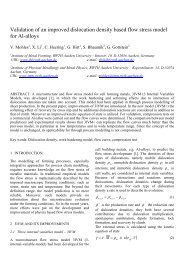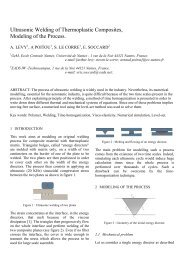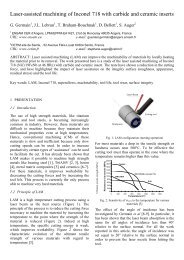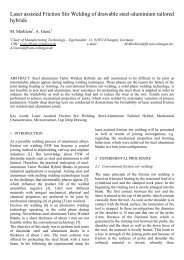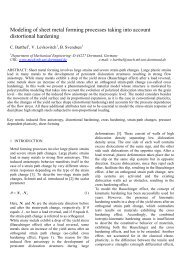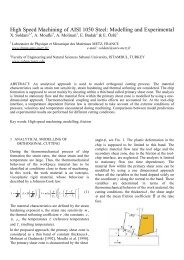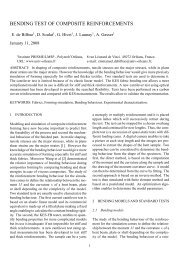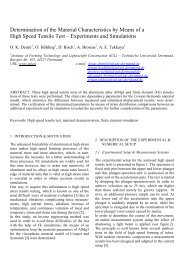<strong>the</strong> experimental one shows nearly no trend to<strong>de</strong>crease. This result confirms our statement in [12],that <strong>the</strong> thickness of lubricant can result in anincrease in punch force, because in micro <strong>de</strong>epdrawing <strong>the</strong> sum of blank thickness and lubricantthickness might be more than <strong>the</strong> drawing clearance.This effect can not be <strong>de</strong>tected in macro <strong>de</strong>epdrawing and was also not implemented in <strong>the</strong> FEMsimulation.For punch diameter of 50 mm, <strong>the</strong> maximum punchforce of <strong>the</strong> simulated curve using friction functionis about 400 N lower than <strong>the</strong> experimental curve,while <strong>the</strong> one using effective friction coefficientshows a difference of about 1000 N, see figure 8.forming processes with consi<strong>de</strong>ration oftribological size effects.• The distribution of contact pressure will be takeninto account in our future work.ACKNOWLEDGEMENTSThe work reported in this paper is fun<strong>de</strong>d by <strong>the</strong> DeutscheForschungsgemeinschaft (DFG) within <strong>the</strong> project “Mo<strong>de</strong>llingof tribological size-effects in <strong>de</strong>ep drawing” (DFG project no.Vo 530/6). The authors would like thank <strong>the</strong> DFG for <strong>the</strong>irbeneficial support.Moreover <strong>the</strong> authors would like thank <strong>the</strong> institute of MetalForming and Casting (UTG) in Munich in Germany for carryout <strong>the</strong> tensile test for <strong>the</strong> Al99.5 in thicknesses of 0.02, 0.1,and 0.2 mm.REFERENCESFig. 8. Comparison of simulated and experimental punch forcevs. punch travel from macro <strong>de</strong>ep drawingThis means <strong>the</strong> <strong>the</strong>ory of Storoschew is not suited tocalculate <strong>the</strong> friction coefficient precisely frommeasured punch force in different dimensions.Oppositely <strong>the</strong> friction functions from strip drawingtests show a good scalability. However, inaccordance to <strong>the</strong> results in strip drawing, <strong>the</strong>simulated punch force vs. punch travel curve doesnot agree with <strong>the</strong> experimental curve perfectly. Thereason for that might be <strong>the</strong> distribution of contactpressure, since <strong>the</strong> local contact zones exist also in<strong>de</strong>ep drawing. Thus in our future work <strong>the</strong>calculation mo<strong>de</strong>l will be enhanced in or<strong>de</strong>r to takeinto account <strong>the</strong> distribution of contact pressure.4 CONCLUSIONS• Tribological size effects were observed in bothscaled strip drawing tests and <strong>de</strong>ep drawing.• The friction functions from strip drawing testscan be integrated into FEM-simulation e.g.ABAQUS. This enables to simulate sheet metal1. F. Vollertsen, Z. Hu, Tribological Size Effects in SheetMetal Forming Measured by a Strip Drawing Test,Annals of CIRP 2006, vol. 55/1, 291-294.2. D.D. Olssen, N. Bay, Prediction of Limits of Lubricationin Strip Reduction Testing, Annals of CIRP 2004, 53/1,231-234.3. P. Becker, H.J. Jeon, C. C. Chang, A.N. Bramley, AGeometric Approach to Mo<strong>de</strong>lling Friction in MetalForming, Annals of CIRP 2003, 52/1, 209-212.4. F. Vollertsen, Z. Hu, H. Schulze Niehoff, C. Theiler,State of <strong>the</strong> art in micro forming and investigations intomicro <strong>de</strong>ep drawing, Journal of Materials ProcessingTechnology, 2004, 151, 70-79.5. N. Tiesler, U. Engel, Microforming – Effects ofMiniaturisation, Proceedings of <strong>the</strong> 8th International<strong>Conference</strong> on Metal Forming, Eds. Pietrzyk, M.,Kusiak, J., ec al., Kraków, 2000, 355-3606. Z. Hu, H. Schulze Niehoff, F. Vollertsen, Determinationof <strong>the</strong> Friction Coefficients in Deep Drawing, Processscaling, eds.: Vollertsen F., Hollmann, F., BIAS-Verlag,ISBN 3-933762-14-6, Strahltechnik 24, 2003, 27-347. Z. Hu, F. Vollertsen, Scaled Friction Test Integrated inDeep Drawing, ICTMP2004, Denmark, Ed. Niels Bay,ISBN: 87-91035-12-0, 561-5688. Z. Hu, F. Vollertsen, Tribological Size Effects in SheetMetal Forming, ICTMP2007, Yokohama, Japan, Ed.Akira Azushima, ISBN 978-4-9903785-0-9, 163-1689. A. B. Richelson, E. van <strong>de</strong>r Giessen, Size Effects inSheet Drawing, 9th International <strong>Conference</strong> on SheetMetal 2001, eds. Duflou, J.R., Geiger, M., et al., 263-27010. A. Messner, Kaltmassivumformung MetallischerKleinstteile –Werkstoffverhalten, Wirkflaechen -reibung, Prozessauslegung-, Eds. Geiger, M., Feldmann,K., ISBN 3-87525-100-8, 199811. M.W. Storoschew, E. A. Popow, Grundlagen <strong>de</strong>rUmformtechnik, VEB Verlag Technik Berlin, 196812. Z. Hu, H. Schulze Niehoff, F. Vollertsen, Tribologicalsize effects in <strong>de</strong>ep drawing, ICNFT2007, eds. F.Vollertsen, S. Yuan, ISBN 978-3-933762-22-1, 573-582
Discrete Element method, a tool to investigate contacts in materialformingI. Iordanoff 1 , D. Richard 2 , S. Tcherniaieff 11 ARTS ET METIER PARITECH, LAMEFIP – Esplana<strong>de</strong> <strong>de</strong>s ARTS et Metiers, Talence, FRANCEURL: www.lamef.bor<strong>de</strong>aux.ensam.fre-mail: ivan.iordanoff@lamef.bor<strong>de</strong>aux.ensam.fr; Serge.tcherniaeff@bor<strong>de</strong>aux.ensam.fr2 <strong>INSA</strong> <strong>de</strong> LYON, LAMCOS – 18-20 Rue <strong>de</strong>s Sciences, 69621 Villeurbanne Ce<strong>de</strong>x, FRANCEURL: lamcos.insa-lyon.fre-mail:david.richard@insa-lyon.fr;ABSTRACT: This paper is <strong>de</strong>voted to <strong>the</strong> <strong>de</strong>scription of a numerical tool that allows <strong>the</strong> local study ofcontacts in material forming: Discrete Element Method (DEM). Discrete Element Methods allow <strong>the</strong> study oflocal properties (cohesion, <strong>the</strong>rmal generation, fractures) on process behavior. This tool is used as moleculardynamics but allows <strong>the</strong> simulation of much representative volumes. Discrete element method is applied as atool to un<strong>de</strong>rstand/propose/confirm, physical scenario involved in <strong>the</strong> contact zone. It is shown in this paperhow such numerical simulations can be used as a complementary tool for forming processes study. Examplesare given on <strong>the</strong>rmal study in cutting process, subsurface damages analysis in abrasion process and weldingjoint characterization in Friction Stir welding.Key words: Discrete Element Method, Abrasion process, Friction Stir welding, Tool Machining.1 INTRODUCTIONDiscrete element method has been wi<strong>de</strong>ly <strong>de</strong>velopedfor rheological study of true discrete materials likesand, pow<strong>de</strong>r and granular materials [1]. In <strong>the</strong> pastten years, <strong>the</strong>ir fields of applications have beenexten<strong>de</strong>d to heterogeneous materials like concrete,biological materials or foams. Their ability tosimulate multi body behavior is used for problemswhere:- A great number of dissociated elements mustbe taken into account,- A great number of <strong>de</strong>fault is encounteredThe main recent fields of applications are multifracturesproblems, where <strong>de</strong>tached elements mustbe taken into account (wear in tribology [2],avalanches in geophysic, milling, grinding …).In material forming or cutting, <strong>the</strong> contact zonebetween <strong>the</strong> tool and <strong>the</strong> working piece is often verydifficult to analyze because:- The affected area has little dimension,- High mechanical, rheological, <strong>the</strong>rmalgradient are involved,- Physical phenomena are highly dynamic.To analyze <strong>the</strong> contact behavior Go<strong>de</strong>t <strong>de</strong>veloped<strong>the</strong> third body concept [3]. This inclu<strong>de</strong>d a<strong>de</strong>scription of <strong>the</strong> formation and movement offragmented particles in <strong>the</strong> interface region. Tostudy <strong>the</strong> behavior of <strong>the</strong> third body insi<strong>de</strong> andoutsi<strong>de</strong> <strong>the</strong> contact, Berthier proposed [4] <strong>the</strong>tribological circuit which allows <strong>the</strong> study of masstransfers insi<strong>de</strong> <strong>the</strong> contact. Based on thistribological circuit and coupling Discrete Elementmo<strong>de</strong>ls (DEM) to experimental, but simplified, wearstudies, Fillot et al [5] proposed a set of equationsthat allows a qualitative mo<strong>de</strong>ling of wear as a massbalance in <strong>the</strong> contact area. Iordanoff et al. [6]showed how abrasion process can be studied as aparticular and controlled wear process.This paper first presents <strong>the</strong> Discrete ElementMethods <strong>de</strong>veloped in <strong>the</strong> special case of materialforming. Then, three examples are given to illustratehow this numerical tool can be used to study localproperties in material forming: investigation of SubSurface Damage in abrasion process, welding jointcharacterization in Friction Stir welding and <strong>the</strong>rmalinvestigation of <strong>the</strong> tool-chip contact during cuttingoperation.



